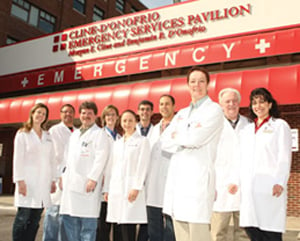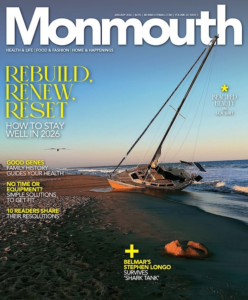Emergency care–improved!
When people need immediate medical care, emergency departments must act quickly and efficiently. But what happens when an ED outgrows its capacity? That was the challenge at Monmouth Medical Center until a recent renovation, because the number of patients using the facility was sharply on the rise. “The last time the department had an overhaul was back in 1987, when we saw just 27,000 patients a year,” says Catherine Hanlon, M.D., Monmouth’s chair of emergency medicine. Now that number has soared to a record 54,000 patients a year.

When people need immediate medical care, emergency departments must act quickly and efficiently. But what happens when an ED outgrows its capacity? That was the challenge at Monmouth Medical Center until a recent renovation, because the number of patients using the facility was sharply on the rise. “The last time the department had an overhaul was back in 1987, when we saw just 27,000 patients a year,” says Catherine Hanlon, M.D., Monmouth’s chair of emergency medicine. Now that number has soared to a record 54,000 patients a year.
In response to this growth, the hospital launched a major upgrade of the ED four years ago, and construction was completed in June. The renovation was made possible by a $3.5 million gift from two donors, Morgan E. Cline and the late Benjamin R. D’Onofrio. Named the Cline-D’Onofrio Emergency Services Pavilion, the newly revamped facility features more treatment beds, an expanded triage area, a new low- acuity care area, technological upgrades and other key improvements.
Recent numbers show the new ED is already achieving success in many critical areas. It has significantly reduced average wait times and turnaround times—the time it takes to be registered and entered into the computer system, evaluated by a doctor or nurse treated and either released or admitted into the hospital. For instance, the average time required for a patient to be placed in a treatment room after his or her arrival at the ED is now 14.7 minutes, down from 23 minutes in 2008. The average turnaround time for discharged patients is 2.9 hours, down from 4 hours in 2008; and for admitted patients it’s 7.5 hours, down from 2008’s 8.8 hours. The percentage of “walkouts”—patients who leave the ED without being seen, usually because of long waits is now just 0.44 percent, down from 1.43 percent in 2008.
These improvements are also producing happier patients: According to the ED’s most recent satisfaction surveys, 90 percent of patients said they were satisfied with the care they received, up from 86.1 percent in 2008 and 79.8 percent in 2007. “The No. 1 indicator for patient satisfaction is wait times, and our satisfaction numbers are a reflection of our lower wait times,” says Dr. Hanlon. The doctor also cites a concerted effort by the staff to keep patients informed of any delays throughout their wait as another reason for the improved satisfaction scores. “If patients don’t know what’s going to happen to them next or how long they’re going to be here, it can make for a very overwhelming experience, so there’s been a lot of staff education on that front,” says Dr. Hanlon.
Highlights of the renovation include a new patient treatment area with 10 beds, which brings the total number of full-capacity ED beds to 28. For patients with more minor illnesses or injuries, such as ankle sprains, earaches or sore throats, a new low-acuity care area offers seven “fast-track beds” for speedy treatment. Other improvements include a newly built registration area and nursing stations; a special Pediatric Emergency Department staffed by pediatric emergency specialists with seven beds and a separate registration and waiting room; and a larger triage area with four beds.
“The expanded triage space is helpful, because when patients sign in we have to be able to do a quick assessment of who’s acute, and we needed a bigger area to reflect the growing number of people coming in which is sometimes 10 to 14 an hour,” says Dr. Hanlon.
Technological improvements, including upgraded computer workstations, have also helped move patients through the ED much more efficiently. Patients can now register at bedside, which gives them a jump- start on care, and cardiac monitors that feed into the nursing stations are now located in almost every room.“We are a chest pain center, so the fact that we are able to turn regular beds into cardiac beds gives us a much greater capacity to treat our cardiac patients,” says Dr. Hanlon.
Even with the ED’s remarkable progress so far, the doctor says she continues to set goals for improvement. As for the two charitable donors who made the renovation possible real estate partners who both received care at the hospital in the past Dr. Hanlon offers sheer gratitude. She notes that since D’Onofrio’s death from cancer last July, Cline has donated an additional $500,000 to complete cosmetic upgrades to the ED, bringing to $4 million the total donations from the pair.
“We’ve received an incredibly generous gift from two great men that is creating a lasting legacy for them in the community,” she says.
Are you prepared? Medical emergencies by their very nature give no warning, but there are things you can do in advance to make sure you’re ready to handle them effectively:
- KEEP INFO HANDY. It helps to keep a folder for each family member showing insurance information, up-to-date immunization history, names and quantities of any medications regularly taken, allergy information and the names and phone numbers of primary care doctors. And know where the folder is so you can grab it on the run.
- MAKE A PHONE LIST. Monmouth Medical Center’s Cline-D’Onofrio Emergency Services Pavilion is at 732-923-7300. Keep this number on an easily accessible list along with Poison Control, 1-800-222-1222; an emergency psychiatric screening number, 732-923- 6999; and the numbers of kids’ schools or day-care centers, adults’ workplaces and the local police and fire departments. www.saintbarnabas.com/hospitals/monmouth_medical/ info/.
- KNOW YOUR WAY. Call 911 if you can’t provide your own prompt, safe transportation. If you can, you’ll want to head for Monmouth’s facility at 300 Second Avenue in Long Branch, just off Pavilion Avenue. But have your travel route clearly in mind; driving confusion is the last thing you’ll need. So post directions in a place you’ll remember (find them online by clicking on “Directions” at www.saintbarnabas.com/hospitals/monmouth_medical/ info/). You may even wish to make a trial run, just for practice.

